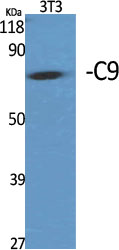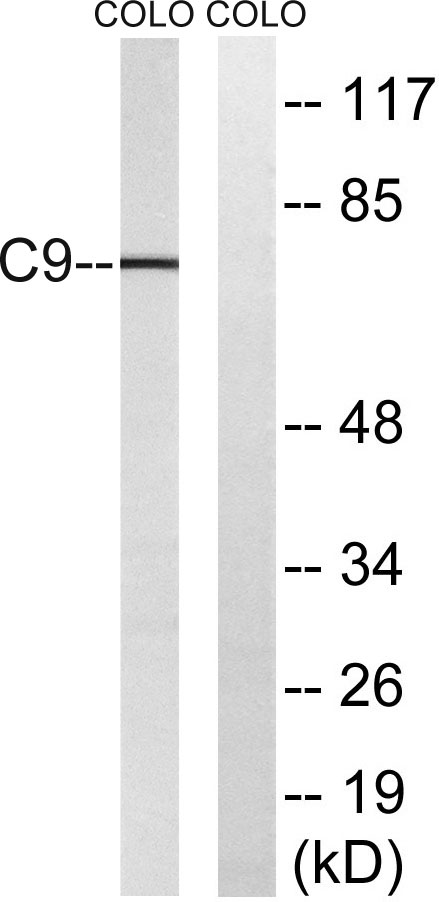C9 Polyclonal Antibody
- Catalog No.:YT0571
- Applications:WB;ELISA
- Reactivity:Human;Rat;Mouse;
- Target:
- C9
- Fields:
- >>Complement and coagulation cascades;>>Prion disease;>>Amoebiasis;>>Coronavirus disease - COVID-19;>>Systemic lupus erythematosus
- Gene Name:
- C9
- Protein Name:
- Complement component C9
- Human Gene Id:
- 735
- Human Swiss Prot No:
- P02748
- Mouse Swiss Prot No:
- P06683
- Immunogen:
- The antiserum was produced against synthesized peptide derived from human C9. AA range:181-230
- Specificity:
- C9 Polyclonal Antibody detects endogenous levels of C9 protein.
- Formulation:
- Liquid in PBS containing 50% glycerol, 0.5% BSA and 0.02% sodium azide.
- Source:
- Polyclonal, Rabbit,IgG
- Dilution:
- WB 1:500 - 1:2000. ELISA: 1:40000. Not yet tested in other applications.
- Purification:
- The antibody was affinity-purified from rabbit antiserum by affinity-chromatography using epitope-specific immunogen.
- Concentration:
- 1 mg/ml
- Storage Stability:
- -15°C to -25°C/1 year(Do not lower than -25°C)
- Other Name:
- C9;Complement component C9
- Observed Band(KD):
- 70kD
- Background:
- This gene encodes the final component of the complement system. It participates in the formation of the Membrane Attack Complex (MAC). The MAC assembles on bacterial membranes to form a pore, permitting disruption of bacterial membrane organization. Mutations in this gene cause component C9 deficiency. [provided by RefSeq, Feb 2009],
- Function:
- disease:Defects in C9 are a cause of component C9 deficiency (C9D) [MIM:120940]. Patients with C9D suffer from recurrent bacterial infections, predominantly from Neisseria meningitidis.,function:C9 is the final component of the complement system to be added in the assembly of the membrane attack complex. It is able to enter lipid bilayers, forming transmembrane channels.,online information:C9 mutation db,PTM:Thrombin cleaves factor C9 to produce C9a and C9b.,similarity:Belongs to the complement C6/C7/C8/C9 family.,similarity:Contains 1 EGF-like domain.,similarity:Contains 1 LDL-receptor class A domain.,similarity:Contains 1 MACPF domain.,similarity:Contains 1 TSP type-1 domain.,
- Subcellular Location:
- Secreted . Target cell membrane ; Multi-pass membrane protein . Secreted as soluble monomer. Oligomerizes at target membranes, forming a pre-pore. A conformation change then leads to the formation of a 100 Angstrom diameter pore. .
- Expression:
- Plasma (at protein level).
- June 19-2018
- WESTERN IMMUNOBLOTTING PROTOCOL
- June 19-2018
- IMMUNOHISTOCHEMISTRY-PARAFFIN PROTOCOL
- June 19-2018
- IMMUNOFLUORESCENCE PROTOCOL
- September 08-2020
- FLOW-CYTOMEYRT-PROTOCOL
- May 20-2022
- Cell-Based ELISA│解您多样本WB检测之困扰
- July 13-2018
- CELL-BASED-ELISA-PROTOCOL-FOR-ACETYL-PROTEIN
- July 13-2018
- CELL-BASED-ELISA-PROTOCOL-FOR-PHOSPHO-PROTEIN
- July 13-2018
- Antibody-FAQs
- Products Images

- Western Blot analysis of various cells using C9 Polyclonal Antibody
.jpg)
- Western Blot analysis of COLO205 cells using C9 Polyclonal Antibody

- Western blot analysis of lysates from COLO cells, using C9 Antibody. The lane on the right is blocked with the synthesized peptide.



